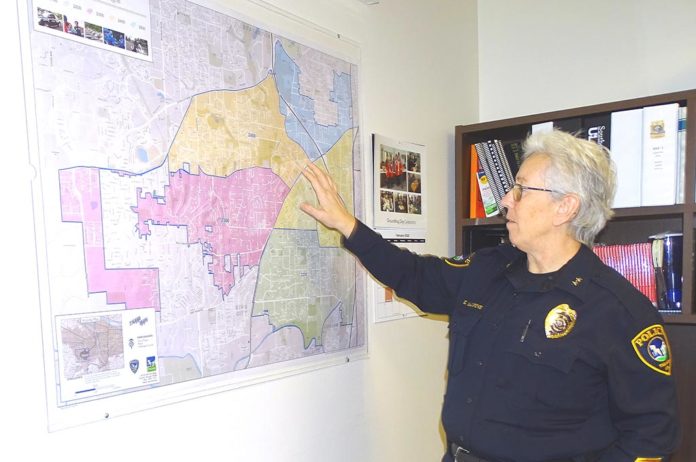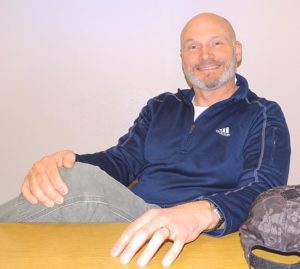
Heather Wakem, a Tigard police officer who currently works the graveyard shift, recalled when a woman in the vicinity of Pacific Highway and Hall Boulevard called 9-1-1. “She was yelling, ‘Stop it! Stop it! Help me!’” Wakem said. “All of us were dealing with another incident, and King City (police) was already helping us. When we got to her location, she was gone.”
Wakem never learned what happened to the woman.
The incident graphically illustrates the frustration felt by police officers and the risk to public safety because of current police staffing levels, which have decreased by 4 percent (three positions) from 2010 to 2018, even though calls for service have increased 27 percent (4,800 more calls annually).
According to Wakem, a good night is when there are not a lot of calls from dispatch except for the occasional bar fight, stolen vehicle or DUII, and she can be proactive.
But not all shifts go smoothly. “Last week a suicide attempt came in,” Wakem said. “A guy was in the bathtub, and he was bloody and drunk and combative. Back-up was 1 ½ minutes away, but he was all sliced up and continuing to slice, and we had to treat his wounds or he would have bled to death. Medical was there with me, and we pulled him out of the tub, but they won’t take over until the situation is safe. Back-up arrived, and we got him strapped to a gurney, and I left to take another call.”
Some nights when Wakem’s shift starts, there are already calls waiting, and the most frustrating part of the job is the lack of time to follow up.
“When we come to a call, we might seem aloof, but they don’t know what we just dealt with,” Wakem added. “It is weird to go from a human tragedy to a neighbor dispute. I’m glad to be there for people on the worst day of their life. That’s why I like doing this.”
Some calls are time-intensive, as getting a warrant issued, for example, takes two hours to write, and then it must be reviewed by district attorney staff before being signed by a judge, an especially difficult task in the middle of the night, even with on-call officials.

“We are a zero-refusal city,” Wakem said. “If a driver suspected of DUII refuses the breathalyzer, we need to get a warrant to draw their blood. If we get the warrant, we have to drive them to Tuality Hospital in Hillsboro, where the warrant has to be read to the suspect and phlebotomist. A round trip to the jail or the hospital takes two hours. If a DUII arrest goes perfectly, it takes two or three hours.”
Then there is the wear and tear on uniforms and bodies. Wakem has had her knee and hip fractured, and one suspect stomped on her foot so hard that her toenail was broken off and only partially grew back.
“We get spit on,” she said. “I’ve had three pairs of glasses broken in one year. Our uniforms get trashed, although now we have canvas external vests, which help a lot.”
Current minimum staffing for the day shift is three officers and a supervisor; for swing shift it is four officers and a supervisor; for graveyard Sunday through Thursday, it is three officers and a supervisor; and for graveyard Friday and Saturday, it is four officers and a supervisor.
Officer Eric Enzenberger agrees with Wakem that at times the police force can be stretched really thin. “We get called to help people, but some people are not getting the help they need,” he said. “We are in reaction mode, not proactive.
“This is a people business. It is about connecting with the community. If you run around all the time with your hair on fire, you don’t develop relationships and you end up behind the 8 ball.”
In his 15 years with the department, Enzenberger has seen “tremendous” changes, especially in making reports and entering property and evidence, not to mention the huge increase in calls.
If Tigard voters approve the public safety measure on the May ballot, “the most important part for us is giving us breathing room,” Enzenberger said. “We would have more flexibility, be able to do more training and participate in extra-curricular programs. We need officers to be on inter-agency teams because it helps us keep up with relationships. We miss out on developing relationships between agencies.”
“As it is now, we don’t get to work in the areas of our strengths. That is where burn-out and turnover happen. And we need the additional officers. I remember one time when the other two officers on duty were dealing with a violent shoplifter and a head-on crash, and I was on a death investigation. All three of us would have wanted another officer there.”

Enzenberger sees the number of officers working per shift as a public safety issue. “We like to back each other up,” he said. “We don’t like to see ourselves spread that thin. If a 2-year-old goes missing, for example, we need a lot of people.”
If the officers are singing to the choir, Chief Kathy McAlpine is the choir director. In the police conference room, she showed graphs from the last several years that show a 24-hour period with green zones (indicating fewest calls) at the top and bottom, yellow zones next to them showing increased call volume, and a red zone in the middle showing the highest volume. What is startling is how the red and yellow zones have widened over the years to reflect increased calls while the green zones continue to shrink.
Leading the department for three years now, McAlpine pointed out that “we’re the caretakers, and my job is to make people aware of what is going on.”
The Tigard Police Department currently has 67 sworn officers with two vacancies. A sergeant and five officers are assigned to TriMet, which pays their salaries, and the chief, two commanders, lieutenants and others also are counted as sworn officers even though they do not respond to calls, which leaves only 34 patrol officers. And there are now only two school resource officers, one at the high school and one who works at the two middle schools.
“We are getting more priority calls, which are an immediate and imminent threat,” McAlpine said. “Response for priority calls is over six minutes, and we want to get it to five. Some types of calls are taking longer to resolve, and they can stack up.”
According to McAlpine, trespass and homeless calls account for 60 percent or more of all calls and are resource intensive. “These are not necessarily criminal behavior and don’t count as crime statistics, but there is a story behind each number,” McAlpine said.
Some question why there are so many vehicles parked in the police parking lot. McAlpine explained that they are necessary because with overlapping shifts, damage done while driving the vehicles at high speed in pursuits, internal damage while transporting suspects, and so on, several can be out of commission at one time.
“I’m not Chicken Little, saying the sky is falling, but police services are eroding, and as the leader, I need to create awareness,” McAlpine said. “People think I’m using scare tactics, but hopefully people will decide I’m authentic, and the facts speak for themselves. We’re here to run into the fire and catch the bad guys, but if all you do is write reports after responding to calls and can’t work proactively, you burn out.”
Measure 34-295 would increase Tigard neighborhood police patrols through a five-year local option levy at a rate of 29 cents per $1,000 of assessed valuation, adding eight patrol officers and an additional school resource officer.





















